You are using an out of date browser. It may not display this or other websites correctly.
You should upgrade or use an alternative browser.
You should upgrade or use an alternative browser.
Hill Forts of Rajasthan
- Thread starter RooFlyer
- Start date
- Status
- Not open for further replies.
- Joined
- Nov 12, 2012
- Posts
- 29,087
- Qantas
- Platinum
- Virgin
- Platinum
- Star Alliance
- Gold
On this trip, I finally succumbed to the iPhone. I took my Sony pocket camera, but on past trips, when I took the same pic at the same point with the Sony and the iphone X, I'm damned if i could tell much of a difference ... except when zoom was required. The vast majority of pics in this report is off the phone. I feel really Gen-Z -ish just pointing the phone, but it worked ... All the videos i'm posting were done on the phone.
For instance, just a simple point-and-shoot shot. Sony on the left, iPhone on the right.
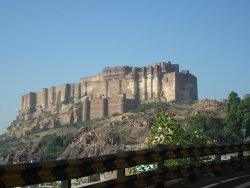
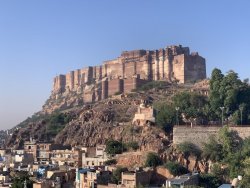
Jodhpur Fort, BTW.
For instance, just a simple point-and-shoot shot. Sony on the left, iPhone on the right.


Jodhpur Fort, BTW.
- Joined
- Nov 12, 2012
- Posts
- 29,087
- Qantas
- Platinum
- Virgin
- Platinum
- Star Alliance
- Gold
Onto Jaisalmer Castle/Fort. it was began in the 12th century by the Rawal Jaisal and became an important stop on the Silk Road. i was happy to learn this, now extending my experience of the Silk Road(s) from Iran and through the 5 Stans . Obviously need Afghanistan and Pakistan now to join them up 
The fort is World Heritage listed. The fort was sieged for 9 years in the late 13th century by the Mughals of Delhi and at the end of the siege, the women committed the ghastly jauhar (more of this in a later post, unfortunately) and the men died in the battle. It changed hands between the Hindu Rajputs and the Muslim Mughals until 1818 when the Hindu Maharawal made a pact with the East India Company. Jaisalmer declined with the partition of India and Pakistan in 1947, when the trade route was closed, but it picked up again after the conflicts between the 2 countries (Indian defence activities). Its now a significant tourist destination, although air routes are tenuous.
The fort is 460m long x 230m wide, with a triple ring of defensive walls. After periods of abandonment, people moved inside the walls to live and there is now 3-4,000 people resident there, its own little town of temples, shops, schools etc.
After driving up to the base, you enter via a zig-zag ramp and four gates. The base of the fort is in poor condition - seepage and weathering is undermining the lower walls. In the pic below, part of the wall on the right has been restored - on the left, as found.
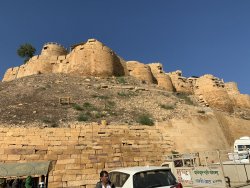
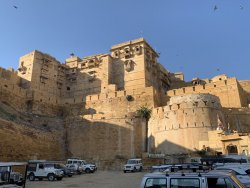
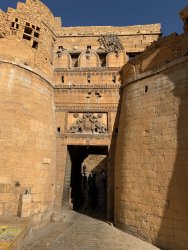
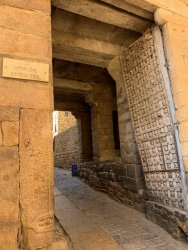
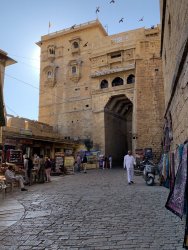
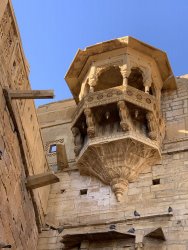
As you pass through the final gate, you come to the main 'courtyard', and the King's palace.
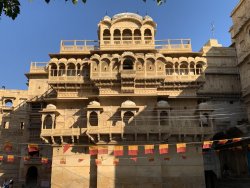
Lots or really interesting laneways and hidden corners:
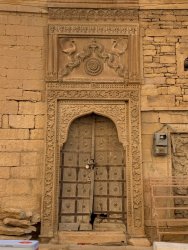
The plaque below shows lotus flowers, the peacock (national bird of India and very prominent in its historical legends) and the wavy symbol - I don't know its name, unfortunately, that is seen in many temples, over gates (eg see third pic in this post) and elsewhere. Does anyone know?
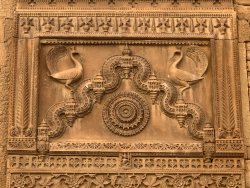
The fort is World Heritage listed. The fort was sieged for 9 years in the late 13th century by the Mughals of Delhi and at the end of the siege, the women committed the ghastly jauhar (more of this in a later post, unfortunately) and the men died in the battle. It changed hands between the Hindu Rajputs and the Muslim Mughals until 1818 when the Hindu Maharawal made a pact with the East India Company. Jaisalmer declined with the partition of India and Pakistan in 1947, when the trade route was closed, but it picked up again after the conflicts between the 2 countries (Indian defence activities). Its now a significant tourist destination, although air routes are tenuous.
The fort is 460m long x 230m wide, with a triple ring of defensive walls. After periods of abandonment, people moved inside the walls to live and there is now 3-4,000 people resident there, its own little town of temples, shops, schools etc.
After driving up to the base, you enter via a zig-zag ramp and four gates. The base of the fort is in poor condition - seepage and weathering is undermining the lower walls. In the pic below, part of the wall on the right has been restored - on the left, as found.






As you pass through the final gate, you come to the main 'courtyard', and the King's palace.

Lots or really interesting laneways and hidden corners:

The plaque below shows lotus flowers, the peacock (national bird of India and very prominent in its historical legends) and the wavy symbol - I don't know its name, unfortunately, that is seen in many temples, over gates (eg see third pic in this post) and elsewhere. Does anyone know?

- Joined
- Nov 12, 2012
- Posts
- 29,087
- Qantas
- Platinum
- Virgin
- Platinum
- Star Alliance
- Gold
A highlight of the fort are the Jain temples. There are seven, but only a couple are open to the public (small fee). Jainism is an ancient religion in India and I first came across the temples of the Jains at the magnificent Ellora site, in central-western India and their temples are always worth a look.
Here, like in many other places, the Jains were a wealthy merchant class who bestowed much of their wealth on their temples ... and houses ... more of the latter, later. i visited the Chandraprabhu and Rikhadev temples, both adjacent to the ticket stand. they were built in the early 1500s.
The Chandraprabhu temple is on two levels in a lay-out I don't really understand, but its worth the visit to admire the carvings.
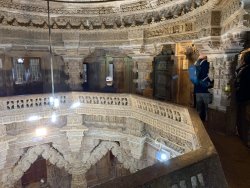
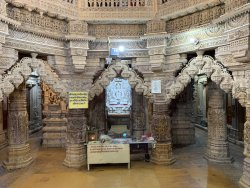
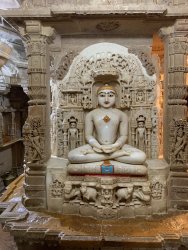
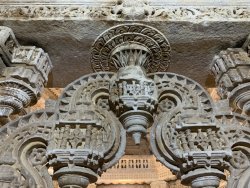
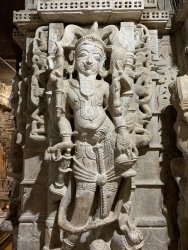
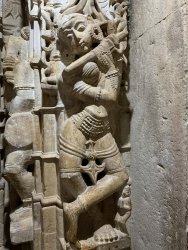
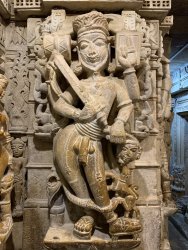
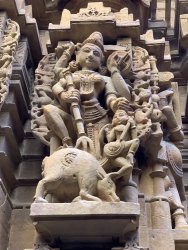
This was the Rikhadev temple.
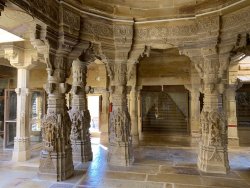
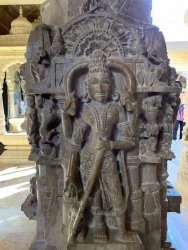
Here, like in many other places, the Jains were a wealthy merchant class who bestowed much of their wealth on their temples ... and houses ... more of the latter, later. i visited the Chandraprabhu and Rikhadev temples, both adjacent to the ticket stand. they were built in the early 1500s.
The Chandraprabhu temple is on two levels in a lay-out I don't really understand, but its worth the visit to admire the carvings.








This was the Rikhadev temple.


- Joined
- Nov 12, 2012
- Posts
- 29,087
- Qantas
- Platinum
- Virgin
- Platinum
- Star Alliance
- Gold
Some views of the town from the fort:

This is the Gadisar lake complex:
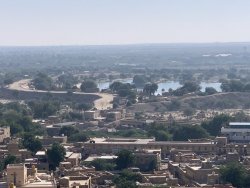
And the large building in the centre of this pic is the haveli we visit next:
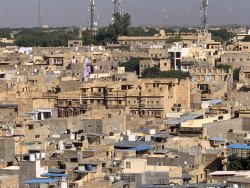
The major Jain merchant families were too wealthy to live in the restricted confines of the fort, so they built in the town below. Two brothers built conjoining houses, and they were, and still are, magnificent, built I think in the 1700s, except the top story which looks incomplete and more recent:
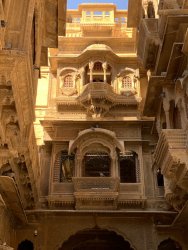
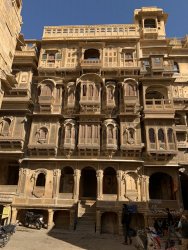
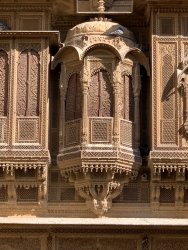
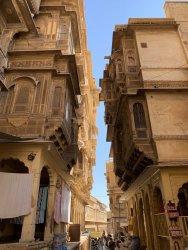
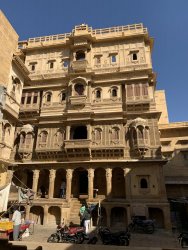
You have to be a bit careful, though - this one is dated 1993! But built out of authentic carved stone, not plaster/cement.
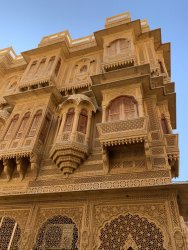

This is the Gadisar lake complex:

And the large building in the centre of this pic is the haveli we visit next:

The major Jain merchant families were too wealthy to live in the restricted confines of the fort, so they built in the town below. Two brothers built conjoining houses, and they were, and still are, magnificent, built I think in the 1700s, except the top story which looks incomplete and more recent:





You have to be a bit careful, though - this one is dated 1993! But built out of authentic carved stone, not plaster/cement.

- Joined
- Nov 12, 2012
- Posts
- 29,087
- Qantas
- Platinum
- Virgin
- Platinum
- Star Alliance
- Gold
Markets on the walk back to the car:
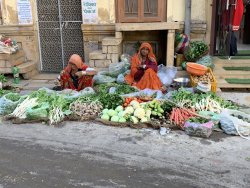
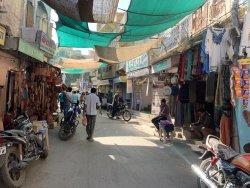
Then we hit the road to Jodhpur, with a last look back at the fort:
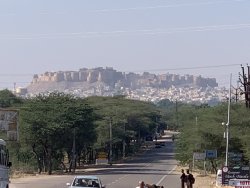
Again, the highway was very good quality:
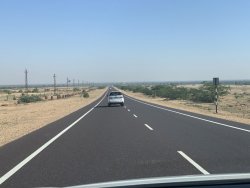
Tolled, of course, but an impressive list of DYKWIA exceptions:
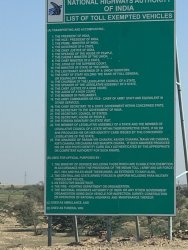
We are skirting the Thar desert, so a few dunes came into view:
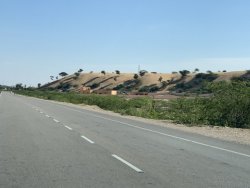
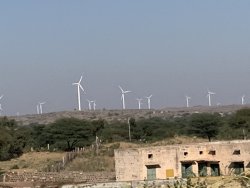
Surprisingly, nearing the major city of Jodhpur, the road turned into 'old style' - narrow and pot-holed. Maybe the military don't need to drive their tanks around here:
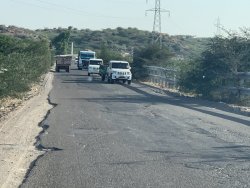
My hotel for two nights here was the Ajit Bhawan. It styles itself as the 'First Heritage Hotel in India'. Its built adjacent to the 1927 red sandstone home of the brother of the Maharajah of Jodhpur and is a somewhat sprawling complex with a distinctly 'African safari' feel about it - its quite weird. Not bad, just strange-feeling compared to the other heritiage placed I'd been in. Getting a bit dated too.
The reception area is nice!
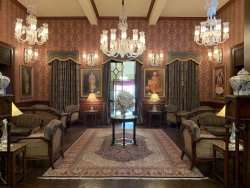
then its a long walk to my room, on a first floor, overlooking a courtyard:
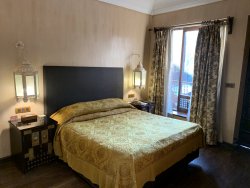


Then we hit the road to Jodhpur, with a last look back at the fort:

Again, the highway was very good quality:

Tolled, of course, but an impressive list of DYKWIA exceptions:

We are skirting the Thar desert, so a few dunes came into view:


Surprisingly, nearing the major city of Jodhpur, the road turned into 'old style' - narrow and pot-holed. Maybe the military don't need to drive their tanks around here:

My hotel for two nights here was the Ajit Bhawan. It styles itself as the 'First Heritage Hotel in India'. Its built adjacent to the 1927 red sandstone home of the brother of the Maharajah of Jodhpur and is a somewhat sprawling complex with a distinctly 'African safari' feel about it - its quite weird. Not bad, just strange-feeling compared to the other heritiage placed I'd been in. Getting a bit dated too.
The reception area is nice!

then its a long walk to my room, on a first floor, overlooking a courtyard:

- Joined
- Nov 12, 2012
- Posts
- 29,087
- Qantas
- Platinum
- Virgin
- Platinum
- Star Alliance
- Gold
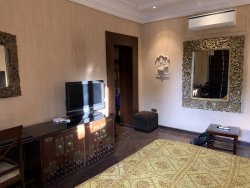
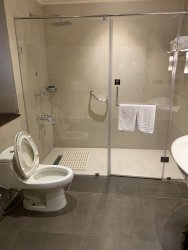
Door, with customary padlock - usually a bit of a PITA to open, especially if you have anything in your hand.
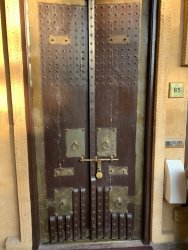
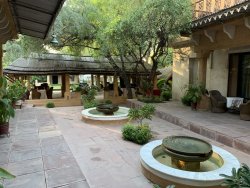
One of the several dining options:
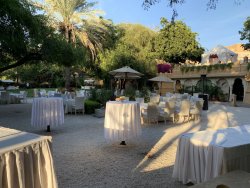
Today was the warmest day of the tour, about 27 degrees, so I planned o go for a swim. No, Sir! Not heated and I doubt ventured above 10 degrees.
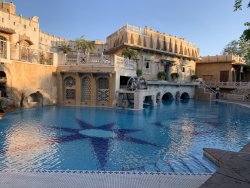
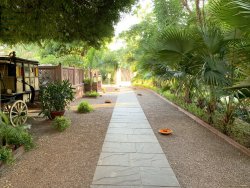
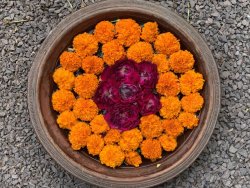
On the suggestion of my driver, I walked around to the local 'bottle-shop' and mini-mart and bought some essential supplies:
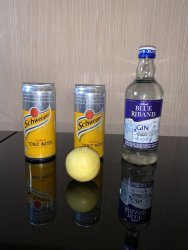
of course always watching where you go (walking on the roads is much safer):
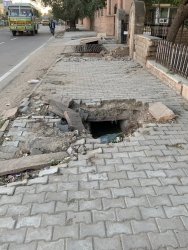
RB
Established Member
- Joined
- Nov 17, 2004
- Posts
- 4,310
Onto Jaisalmer Castle/Fort. it was began in the 12th century by the Rawal Jaisal and became an important stop on the Silk Road. i was happy to learn this, now extending my experience of the Silk Road(s) from Iran and through the 5 Stans . Obviously need Afghanistan and Pakistan now to join them up
The fort is World Heritage listed. The fort was sieged for 9 years in the late 13th century by the Mughals of Delhi and at the end of the siege, the women committed the ghastly jauhar (more of this in a later post, unfortunately) and the men died in the battle. It changed hands between the Hindu Rajputs and the Muslim Mughals until 1818 when the Hindu Maharawal made a pact with the East India Company. Jaisalmer declined with the partition of India and Pakistan in 1947, when the trade route was closed, but it picked up again after the conflicts between the 2 countries (Indian defence activities). Its now a significant tourist destination, although air routes are tenuous.
The fort is 460m long x 230m wide, with a triple ring of defensive walls. After periods of abandonment, people moved inside the walls to live and there is now 3-4,000 people resident there, its own little town of temples, shops, schools etc.
After driving up to the base, you enter via a zig-zag ramp and four gates. The base of the fort is in poor condition - seepage and weathering is undermining the lower walls. In the pic below, part of the wall on the right has been restored - on the left, as found.
View attachment 200128
View attachment 200129
View attachment 200130
View attachment 200131
View attachment 200132
View attachment 200133
As you pass through the final gate, you come to the main 'courtyard', and the King's palace.
View attachment 200134
Lots or really interesting laneways and hidden corners:
View attachment 200135
The plaque below shows lotus flowers, the peacock (national bird of India and very prominent in its historical legends) and the wavy symbol - I don't know its name, unfortunately, that is seen in many temples, over gates (eg see third pic in this post) and elsewhere. Does anyone know?
View attachment 200136
I have taken the liberty on checking with Magan to get an answer. So I understand it is the Peacocks, the lotus is actually the Chakra of God Vishnu (Vishnu is seen as a protector). From what I understand the other piece that has what looks like turrets is the Toran Dwar of a religious place or Royal House. Hope I have interpreted the answer correctly
- Joined
- Nov 12, 2012
- Posts
- 29,087
- Qantas
- Platinum
- Virgin
- Platinum
- Star Alliance
- Gold
Dinner in-house, and another excellent vegetarian spread:
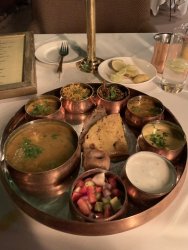
The fort at Jodhpur is renowned as one of the more spectacular forts in Rajesthan, so i was hoping for a clear day; we had all day in the city.
No problems in that regard!
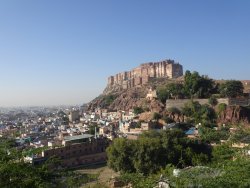
To get some scale, this is a zoom in of the top right-hand corner:
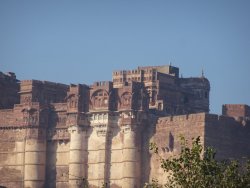
Talk about lording it over the great unwashed ...
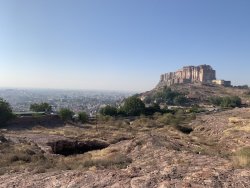
The last pic was taken from our first stop of the day, the Jaswant Thada, or Maharajah Jaswant Sing's marble cremation pyre location and memorial, built only in 1899. After he, and nearby, his family members were cremated, the remains were then interred into the Ganges.
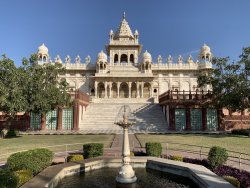
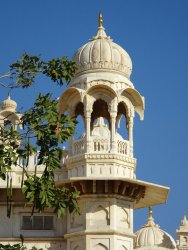
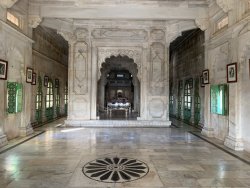
Nearby cremation memorials of family members:
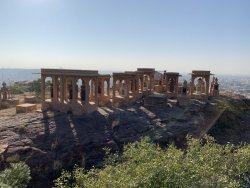
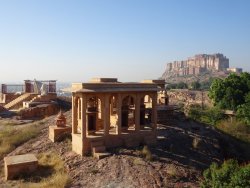
In the distance you can see the current Maharajah's Umaid Bhawan Palace (and hotel):
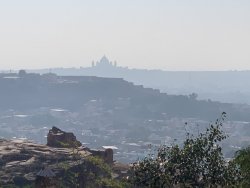

The fort at Jodhpur is renowned as one of the more spectacular forts in Rajesthan, so i was hoping for a clear day; we had all day in the city.
No problems in that regard!

To get some scale, this is a zoom in of the top right-hand corner:

Talk about lording it over the great unwashed ...

The last pic was taken from our first stop of the day, the Jaswant Thada, or Maharajah Jaswant Sing's marble cremation pyre location and memorial, built only in 1899. After he, and nearby, his family members were cremated, the remains were then interred into the Ganges.



Nearby cremation memorials of family members:


In the distance you can see the current Maharajah's Umaid Bhawan Palace (and hotel):

Last edited:
- Joined
- Nov 12, 2012
- Posts
- 29,087
- Qantas
- Platinum
- Virgin
- Platinum
- Star Alliance
- Gold
I have taken the liberty on checking with Magan to get an answer. So I understand it is the Peacocks, the lotus is actually the Chakra of God Vishnu (Vishnu is seen as a protector). From what I understand the other piece that has what looks like turrets is the Toran Dwar of a religious place or Royal House. Hope I have interpreted the answer correctly
Good idea! Thanks. Doing a bit of Googling, looks like 'Toran Dwar' is the overall ceremonial archway entrance to a temple etc. I was particularly wondering about the wavy thing which as you noted has sorts of turrets on it. It may be a Jain thing ... we'll see it again at other sites.
- Joined
- Nov 12, 2012
- Posts
- 29,087
- Qantas
- Platinum
- Virgin
- Platinum
- Star Alliance
- Gold
The mighty fort at Jodhpur is known as Mehrangarh and there, I was offered an elevator at this point:
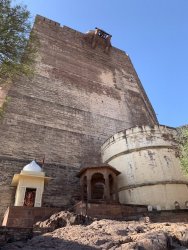
... obviously didn't know me! That's one of the water wheels at the top there - ie to lift water up to the internal reservoirs.
So through one of several gates - like Jaisalmar a series of gates in a zig-zag path:
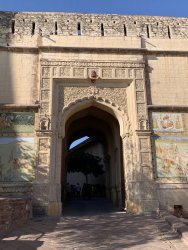
Ganesh doing the honours:
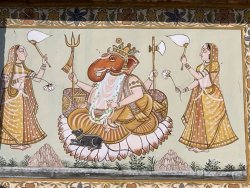
Up there? Hmmm .. did someone mention an elevator?
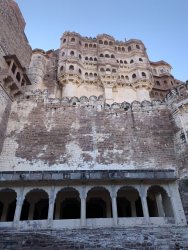
In the following pic, you can see the indentations of where cannon balls hit in 1808 during an attack by forces of the Jaipur king, under control of the Mughals. The locals held the fort, then added an extra outer wall.
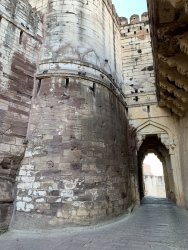
Up and up, with the 'new' wall on the left.
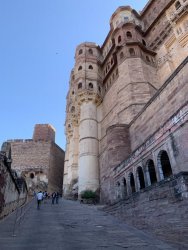
Jodhpur is known as the 'blue city'
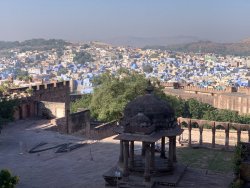
Another gate:
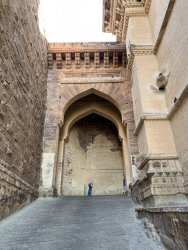
In a previous post I mentioned the awful practice of jauhar. Simply (and do look up the wiki explanation) when a city/fort was under attack and expected to be over-whelmed, the men and boys would go out to die in the battle; the women and girls would systematically throw themselves onto massive pyres, semi-immolating to prevent capture, enslavement, rape etc. They would die by the thousands; unfortunately it comes up regularly on this tour.
There are hand-prints made by some of the women at Mehrangarh prior to their sacrifice:
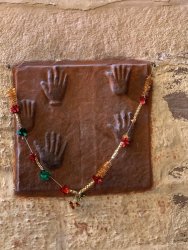

... obviously didn't know me! That's one of the water wheels at the top there - ie to lift water up to the internal reservoirs.
So through one of several gates - like Jaisalmar a series of gates in a zig-zag path:

Ganesh doing the honours:

Up there? Hmmm .. did someone mention an elevator?

In the following pic, you can see the indentations of where cannon balls hit in 1808 during an attack by forces of the Jaipur king, under control of the Mughals. The locals held the fort, then added an extra outer wall.

Up and up, with the 'new' wall on the left.

Jodhpur is known as the 'blue city'

Another gate:

In a previous post I mentioned the awful practice of jauhar. Simply (and do look up the wiki explanation) when a city/fort was under attack and expected to be over-whelmed, the men and boys would go out to die in the battle; the women and girls would systematically throw themselves onto massive pyres, semi-immolating to prevent capture, enslavement, rape etc. They would die by the thousands; unfortunately it comes up regularly on this tour.
There are hand-prints made by some of the women at Mehrangarh prior to their sacrifice:

- Joined
- Nov 12, 2012
- Posts
- 29,087
- Qantas
- Platinum
- Virgin
- Platinum
- Star Alliance
- Gold
The Mehrangarh was built or started around 1459 by Rao Jodha but most of what is seen today was built by Jaswant Singh in the 1600s. There are seven gates today and a number of separate palaces within the walls. Much of the fort is a museum of the ruling family's artefacts.
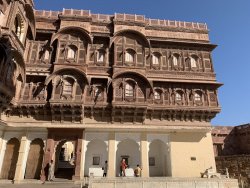
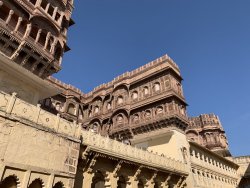
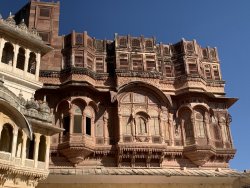
The museum part got a bit monotonous after the others I had visited - lots of armour etc. But the elephant seats (howdah) and palanquins here were good. Mostly silver plated:
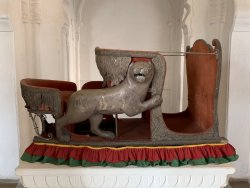
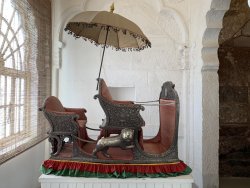
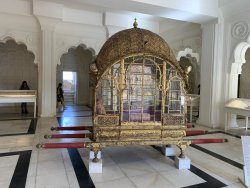
Views over the old 'blue' city. We walked down through the walkways and ramps below this view, into the 'old' town.
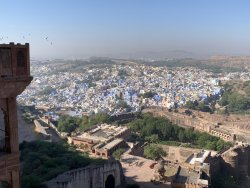
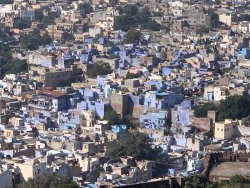



The museum part got a bit monotonous after the others I had visited - lots of armour etc. But the elephant seats (howdah) and palanquins here were good. Mostly silver plated:



Views over the old 'blue' city. We walked down through the walkways and ramps below this view, into the 'old' town.


- Joined
- Nov 12, 2012
- Posts
- 29,087
- Qantas
- Platinum
- Virgin
- Platinum
- Star Alliance
- Gold
Two pics looking back on descent - you can see that you only get to see a fraction of the fort - there is a km or more enclosed by the walls, being animal grazing, barracks, reservoirs etc.

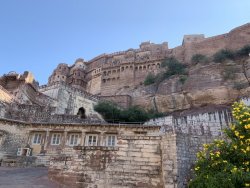
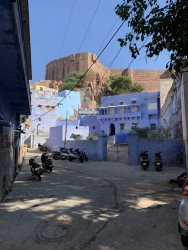
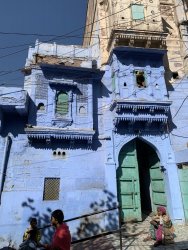
We ended up at the Sardar market - it was early, so still a bit quiet, and the century-old clock-tower.
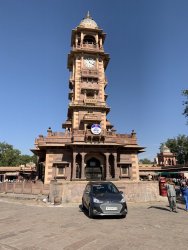
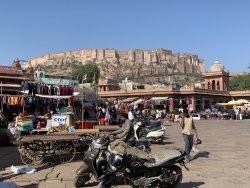
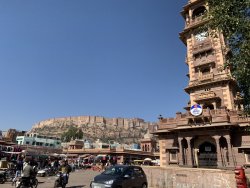
Oh, this guy is apparently the local dentist in his surgery
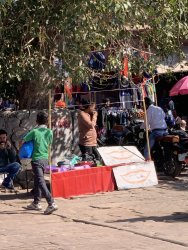




We ended up at the Sardar market - it was early, so still a bit quiet, and the century-old clock-tower.



Oh, this guy is apparently the local dentist in his surgery

- Joined
- Nov 12, 2012
- Posts
- 29,087
- Qantas
- Platinum
- Virgin
- Platinum
- Star Alliance
- Gold
After the tour my driver took me to check out the Umaid Bhawan Palace - both the home palace of the current Maharajah (but only the world's sixth largest private residence  ) and a hotel!!
) and a hotel!!
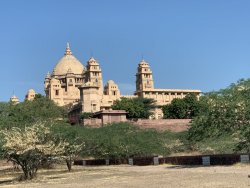
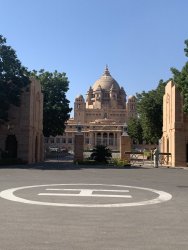
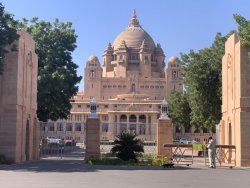
Its about A$900/night plus at least 18% GST, low season. I'm sure someone will be able to give us a review, at some point, but they wouldn't even let me near the gates!!
The Palace/hotel is surrounded by a sub-division sold off by the Maharajah ... some very swanky places ...
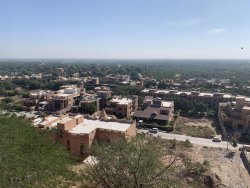
Back at the hotel, i was told that there was a late-booked event occupying the outside restaurant, which was a bit annoying, but I was able to gate crash the floor show:
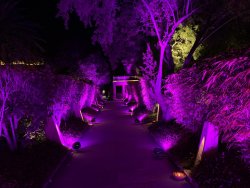
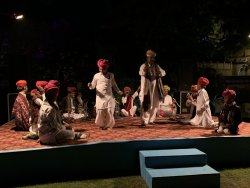
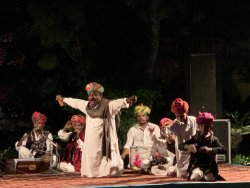



Its about A$900/night plus at least 18% GST, low season. I'm sure someone will be able to give us a review, at some point, but they wouldn't even let me near the gates!!
The Palace/hotel is surrounded by a sub-division sold off by the Maharajah ... some very swanky places ...

Back at the hotel, i was told that there was a late-booked event occupying the outside restaurant, which was a bit annoying, but I was able to gate crash the floor show:



craven morehead
Established Member
- Joined
- Aug 1, 2008
- Posts
- 2,706
- Qantas
- Platinum
- Virgin
- Gold
View attachment 200318
View attachment 200319
Door, with customary padlock - usually a bit of a PITA to open, especially if you have anything in your hand.
View attachment 200320
View attachment 200321
One of the several dining options:
View attachment 200322
Today was the warmest day of the tour, about 27 degrees, so I planned o go for a swim. No, Sir! Not heated and I doubt ventured above 10 degrees.
View attachment 200323
View attachment 200324
View attachment 200325
On the suggestion of my driver, I walked around to the local 'bottle-shop' and mini-mart and bought some essential supplies:
View attachment 200327
of course always watching where you go (walking on the roads is much safer):
View attachment 200326
How was the Gin ?
- Joined
- Nov 12, 2012
- Posts
- 29,087
- Qantas
- Platinum
- Virgin
- Platinum
- Star Alliance
- Gold
At A$3 for a half-bottle, it was OK!
- Joined
- Nov 12, 2012
- Posts
- 29,087
- Qantas
- Platinum
- Virgin
- Platinum
- Star Alliance
- Gold
The next day was a short-ish drive day to Narlai, which is a hotel we chose in the area of the Jain temple at Ranakpur.
The roads of Jodhpur are pretty good - 4 lane divided main roads, with round-abouts and traffic lights that for the main part, were observed. unfortunately we struck a traffic jam, which looked pretty stuck. I thought we could turn off and dog-leg around the blockage, going a little out of the way.
Ha! My driver, ever resourceful and experienced, merely turned into the 2 on-coming lanes of traffic and proceeded apace. OK, we slowed a bit, but the on-coming cars and motorbikes were remarkably forgiving. After a km or 2 we were abole to turn back onto the right ride of the road, having lost little time to the traffic jam.
Out on the country roads, we stopped by a shrine to a biker who died at this spot:
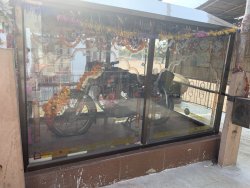
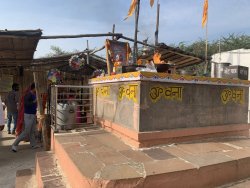
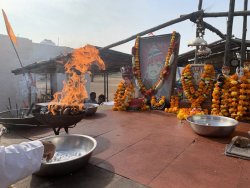
Narlai is a small village at the foot of a large granite rock hill. Some colourful locals, men and women:
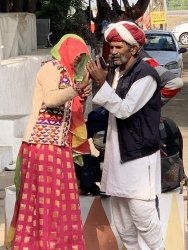
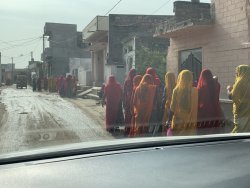
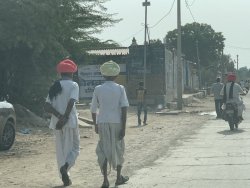
As with some of the other hotels, the approach through the village doesn't fill you with confidence, but as before, the hotel was a haven of comfort.
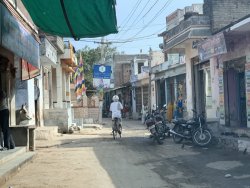
The roads of Jodhpur are pretty good - 4 lane divided main roads, with round-abouts and traffic lights that for the main part, were observed. unfortunately we struck a traffic jam, which looked pretty stuck. I thought we could turn off and dog-leg around the blockage, going a little out of the way.
Ha! My driver, ever resourceful and experienced, merely turned into the 2 on-coming lanes of traffic and proceeded apace. OK, we slowed a bit, but the on-coming cars and motorbikes were remarkably forgiving. After a km or 2 we were abole to turn back onto the right ride of the road, having lost little time to the traffic jam.
Out on the country roads, we stopped by a shrine to a biker who died at this spot:



Narlai is a small village at the foot of a large granite rock hill. Some colourful locals, men and women:



As with some of the other hotels, the approach through the village doesn't fill you with confidence, but as before, the hotel was a haven of comfort.

Read our AFF credit card guides and start earning more points now.
AFF Supporters can remove this and all advertisements
- Joined
- Nov 12, 2012
- Posts
- 29,087
- Qantas
- Platinum
- Virgin
- Platinum
- Star Alliance
- Gold
The hotel was the Rawla Narlai, a 17th century fortress, restored in the early 1900s for use by the Maharajah and his family as a 'retreat' and turned into a hotel I think 20 or so years ago. There is a hertiage wing, where I was, and a 'contemporary' wing, set back a bit such that I didn't know it was there until I was looking around before I left.
Entry court yard:
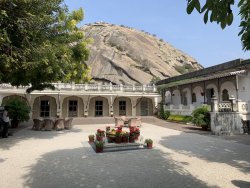
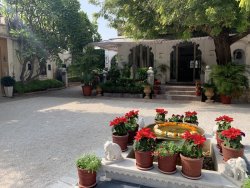
Pool, the over-looking hill; my room on the right. Note right on the top of the hill, something white - its a 'white elephant' and more of him tomorrow.
and more of him tomorrow.
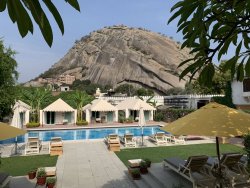
Looking internally from outside my room:
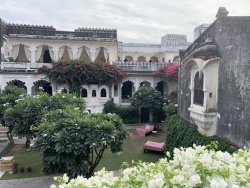
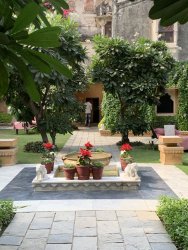
And entrance to my digs - the whole place is pretty open:
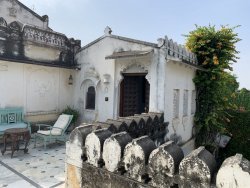
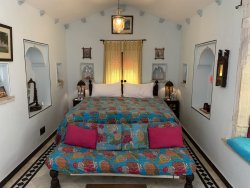
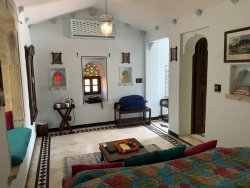
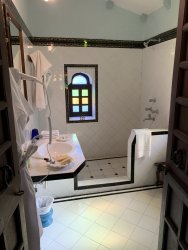
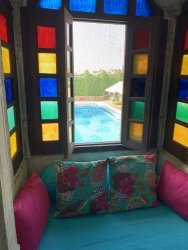
To be honest, it was a bit grotty in detail and needs a good paint job, but comfortable enough.
Entry court yard:


Pool, the over-looking hill; my room on the right. Note right on the top of the hill, something white - its a 'white elephant'

Looking internally from outside my room:


And entrance to my digs - the whole place is pretty open:





To be honest, it was a bit grotty in detail and needs a good paint job, but comfortable enough.
Last edited:
- Joined
- Nov 12, 2012
- Posts
- 29,087
- Qantas
- Platinum
- Virgin
- Platinum
- Star Alliance
- Gold
The floor show just coming to an end; it was G&Ts on the terrace ... very nice.
Then dinner on the roof top. Probably a 4* experience overall for this hotel. They offer a lot of extra activities here - a leopard-spotting safari, village temples walk, dinner under the stars etc. Quite expensive though.
The white elephant showing up again:
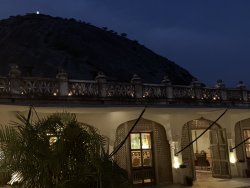
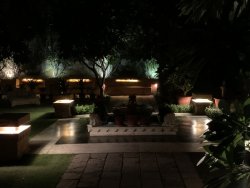
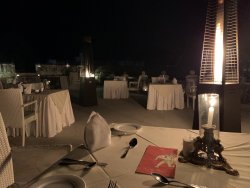
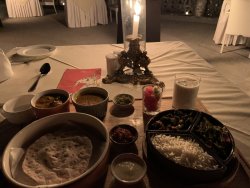
Then dinner on the roof top. Probably a 4* experience overall for this hotel. They offer a lot of extra activities here - a leopard-spotting safari, village temples walk, dinner under the stars etc. Quite expensive though.
The white elephant showing up again:




- Joined
- Nov 12, 2012
- Posts
- 29,087
- Qantas
- Platinum
- Virgin
- Platinum
- Star Alliance
- Gold
One activity I did take was a free accompanied walk up the hill at dawn. Its 756 steps to the top and 1/3 of the way up, I was thinking that it seemed like a good idea at the time:
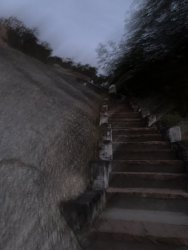
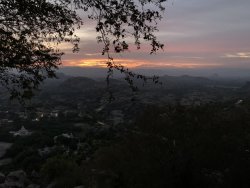
The guide must have been in his 70s or 80s; he does this almost every day and went up the hill like a rabbit.
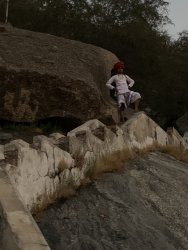
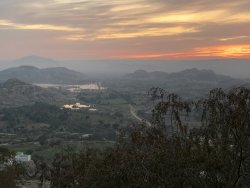
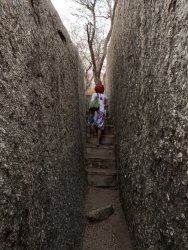
The hotel from the top:
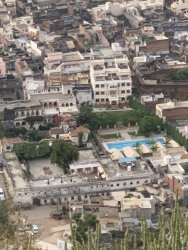
Aforementioned white elephant ...
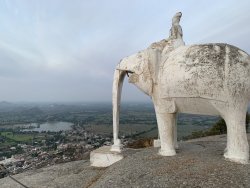
And of course tea at the top.
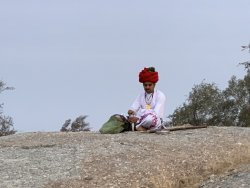


The guide must have been in his 70s or 80s; he does this almost every day and went up the hill like a rabbit.



The hotel from the top:

Aforementioned white elephant ...

And of course tea at the top.

- Status
- Not open for further replies.
Become an AFF member!
Join Australian Frequent Flyer (AFF) for free and unlock insider tips, exclusive deals, and global meetups with 65,000+ frequent flyers.AFF members can also access our Frequent Flyer Training courses, and upgrade to Fast-track your way to expert traveller status and unlock even more exclusive discounts!

AFF forum abbreviations
Wondering about Y, J or any of the other abbreviations used on our forum?Check out our guide to common AFF acronyms & abbreviations.














